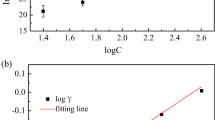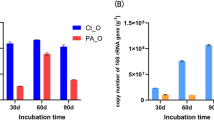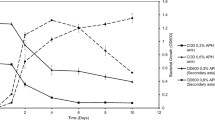Abstract
In this study, a distinct inoculum was investigated as an isolated variable within sequencing batch reactors via a comparison of the 4-fluoroaniline (4-FA) or 2,4-difluoroaniline (2,4-DFA) removal amounts. The inocula were derived from a treatment plant for treating pharmaceutical wastewater plus a small amount of municipal sewage (PMS), a treatment plant for treating fluoridated hydrocarbon wastewater (FHS), and a treatment plant for treating the comprehensive wastewater in an industrial park (CIS). There were slight differences among the degradation patterns of the 4-FA for the three inocula, whether during the enrichment period or the high concentration shock period. In contrast, it was observed that the degradation efficiency of 2,4-DFA initially varied with the inocula. The FHS-derived inoculum was determined to be optimal, exhibiting the earliest degradation reaction only after an acclimation of 7 days had the highest degradation rate constant of 0.519 h−1, and had the fastest recovery time of three weeks after high concentration shock. Additionally, compared with the PMS-derived inoculum, the CIS-derived inoculum exhibited an earlier degradation reaction within three weeks, and a higher microbial diversity, but a lower shock resistance and degradation rate constant of 0.257 h−1. High-throughput sequencing demonstrated that each final consortium was different in composition, and the microbial consortia developed well on the inoculum and substrate. In comparison of the similarity among the three 2,4-DFA enrichment cultures, the higher similarity (63.9–70.0%) among three final consortia enriching with 4-FA was observed. The results indicated that the inoculum played an important role in the degradation of FAs and the microbial bacterial communities of final consortia, and the effect extent might well depend on the fluorinated level of FAs.






Similar content being viewed by others
References
Adams DEC, Halden RU (2010) Fluorinated chemicals and the impacts of anthropogenic use. ACS Symp Ser 1048:539–560
Alexandrino DAM, Ribeiro I, Pinto LM, Cambra R, Oliveira RS, Pereira F, Carvalho MF (2018) Biodegradation of mono-, di- and trifluoroacetate by microbial cultures with different origins. New Biotechnol 43:23–29. https://doi.org/10.1016/j.nbt.2017.08.005
Alves APA, Lima PS, Dezotti M, Bassin JP (2017) Impact of phenol shock loads on the performance of a combined activated sludge-moving bed biofilm reactor system. Int Biodeter Biodegr 123:146–155. https://doi.org/10.1016/j.ibiod.2017.06.015
Amorim CL, Carvalho MF, Afonso CMM, Castro PML (2013) Biodegradation of fluoroanilines by the wild strain Labrys portucalensis. Int Biodeter Biodegr 80:10–15. https://doi.org/10.1016/j.ibiod.2013.02.001
APHA, AWWA (2005) Standard methods for the examination of water and wastewater. American Public Health Association, Washington, DC
Braun F, Hamelin J, Bonnafous A, Delgenes N, Steyer JP, Patureau D (2015) Similar PAH fate in anaerobic digesters inoculated with three microbial communities accumulating either volatile fatty acids or methane. PLoS ONE 10(4):1–20
Breugelmans P, Leroy B, Bers K, Dejonghe W, Wattiez R, De Mot R, Springael D (2010) Proteomic study of linuron and 3,4-dichloroaniline degradation by Variovorax sp WDL1: evidence for the involvement of an aniline dioxygenase-related multicomponent protein. Res Microbiol 161:208–218. https://doi.org/10.1016/j.resmic.2010.01.010
Carvalho G et al (2010) Biological treatment of propanil and 3,4-dichloroaniline: kinetic and microbiological characterisation. Water Res 44:4980–4991. https://doi.org/10.1016/j.watres.2010.08.06
Chen YW et al (2019) Microbial community assembly in detergent wastewater treatment bioreactors: influent rather than inoculum source plays a more important role. Bioresour Technol 287:121467. https://doi.org/10.1016/j.biortech.2019.121467
Chettri B, Singh AK (2019) Kinetics of hydrocarbon degradation by a newly isolated heavy metal tolerant bacterium Novosphingobium panipatense P5:ABC. Bioresour Technol 294:122190
Cho K, Choi M, Lee S, Bae H (2018) Negligible seeding source effect on the final ANAMMOX community under steady and high nitrogen loading rate after enrichment using poly(vinyl alcohol) gel carriers. Chemosphere 208:21–30. https://doi.org/10.1016/j.chemosphere.2018.05.155
Chong NM, Chen YS (2007) Activated sludge treatment of a xenobiotic with or without a biogenic substrate during start-up and shocks. Bioresour Technol 98:3611–3616. https://doi.org/10.1016/j.biortech.2006.11.031
Cortes-Tolalpa L, Jimenez DJ, Brossi MJD, Salles JF, van Elsas JD (2016) Different inocula produce distinctive microbial consortia with similar lignocellulose degradation capacity. Appl Microbiol Biotechnol 100:7713–7725. https://doi.org/10.1007/s00253-016-7516-6
Cui DZ, Shen D, Wu CR, Li C, Leng DJ, Zhao M (2017) Biodegradation of aniline by a novel bacterial mixed culture AC. Int Biodeter Biodegr 125:86–96. https://doi.org/10.1016/j.ibiod.2017.08.010
Dejonghe W, Goris J, Dierickx A, De Dobbeleer V, Crul K, De Vos P, Verstraete W, Top EM (2002) Diversity of 3-chloroaniline and 3,4-dichloroaniline degrading bacteria isolated from three different soils and involvement of their plasmids in chloroaniline degradation. Fems Microbiol Ecol 42:315–325. https://doi.org/10.1111/J.1574-6941.2002.Tb01021.X
Ding AQ, Zhao D, Ding F, Du SW, Lu HJ, Zhang M, Zheng P (2018) Effect of inocula on performance of bio-cathode denitrification and its microbial mechanism. Chem Eng J 343:399–407. https://doi.org/10.1016/j.cej.2018.02.119
Duque AF, Bessa VS, Carvalho MF, de Kreuk MK, van Loosdrecht MCM, Castro PML (2011) 2-Fluorophenol degradation by aerobic granular sludge in a sequencing batch reactor. Water Res 45:6745–6752. https://doi.org/10.1016/j.watres.2011.10.033
Eadsforth CV, Logan CJ, Morrison BJ, Warburton PA (1984) 2,4-difluoroaniline and 4-fluoroaniline exposure - monitoring by methemoglobin and urine analyses. Int Arch Occup Environ Health 54:223–232. https://doi.org/10.1007/Bf00379051
Edgar RC (2010) Search and clustering orders of magnitude faster than BLAST. Bioinformatics 26:2460–2461. https://doi.org/10.1093/bioinformatics/btq461
Fan XY, Gao JF, Pan KL, Li DC, Zhang LF, Wang SJ (2018) Shifts in bacterial community composition and abundance of nitrifiers during aerobic granulation in two nitrifying sequencing batch reactors. Bioresour Technol 251:99–107. https://doi.org/10.1016/j.biortech.2017.12.038
Guo GY, Guan J, Sun SQ, Liu J, Zhao YJ (2020) Nutrient and heavy metal removal from piggery wastewater and CH4 enrichment in biogas based on microalgae cultivation technology under different initial inoculum concentration. Water Environ Res 92:922–933. https://doi.org/10.1002/wer.1287
Hou LF, Wu QP, Gu QH, Zhou Q, Zhang JM (2018) Community structure analysis and biodegradation potential of aniline-degrading bacteria in biofilters. Curr Microbiol 75:918–924. https://doi.org/10.1007/s00284-018-1466-4
Jiang Y, Wei L, Yang K, Wang HY (2019a) Investigation of rapid granulation in SBRs treating aniline-rich wastewater with different aniline loading rates. Sci Total Environ 646:841–849. https://doi.org/10.1016/j.scitotenv.2018.07.313
Jiang Y, Yang K, Shang Y, Zhang HN, Wei L, Wang HY (2019b) Response and recovery of aerobic granular sludge to pH shock for simultaneous removal of aniline and nitrogen. Chemosphere 221:366–374. https://doi.org/10.1016/j.chemosphere.2018.12.207
Jiao S, Chen WM, Wang ET, Wang JM, Liu ZS, Li YN, Wei GH (2016) Microbial succession in response to pollutants in batch-enrichment culture. Sci Rep 6:2179110
Kafilzadeh F, Khezri A (2015) Isolation and molecular characterization of aniline resistant bacteria from soil around shiraz refinery. Fresenius Environ Bull 24:2232–2237
Khehra MS, Saini HS, Sharma DK, Chadha BS, Chimni SS (2005) Decolorization of various azo dyes by bacterial consortium. Dyes Pigm 67:55–61
Kiel M, Engesser KH (2015) The biodegradation vs. biotransformation of fluorosubstituted aromatics. Appl Microbiol Biotechnol 99:7433–7464. https://doi.org/10.1007/s00253-015-6817-5
Kim S, Rossmassler K, Broeckling CD, Galloway S, Prenni J, De Long SK (2017) Impact of inoculum sources on biotransformation of pharmaceuticals and personal care products. Water Res 125:227–236. https://doi.org/10.1016/j.watres.2017.08.041
Li C, Zhang X, Lu Y, Fan Z, Wang TC, Zhang GL (2020a) Cometabolic degradation of p-chloroaniline by the genus Brevibacillus bacteria with extra carbon sources. J Hazard Mater 383:121198
Li Y, Zhang Q, Li M, Sang WJ, Wang Y, Wu LF, Yang YQ (2020b) Bioaugmentation of sequencing batch reactor for aniline treatment during start-up period: investigation of microbial community structure of activated sludge. Chemosphere 243:125426
Moreno B, Gomez MA, Ramos A, Gonzalez-Lopez J, Hontoria E (2005) Influence of inocula over start up of a denitrifying submerged filter applied to nitrate contaminated groundwater treatment. J Hazard Mater 127:180–186. https://doi.org/10.1016/j.jhazmat.2005.07.002
Mosneang CL, Grozea A, Oprescu I, Dumitrescu E, Muselin F, Gal D, Cristina RT (2014) Assessment of 2,4-difluoroaniline aquatic toxicity using A Zebrafish (Danio rerio) model. Thai J Vet Med 44:445–452
Movahedyan H, Assadi A, Amin MM (2008) Effects of 4-chlorophenol loadings on acclimation of biomass with optimized fixed time sequencing batch reactor. Iran J Environ Health 5:225–234
Murphy CD (2016) Microbial degradation of fluorinated drugs: biochemical pathways, impacts on the environment and potential applications. Appl Microbiol Biotechnol 100:2617–2627. https://doi.org/10.1007/s00253-016-7304-3
Orozco AMF, Lobo CC, Contreras EM, Zaritzky NE (2013) Biodegradation of bisphenol-A (BPA) in activated sludge batch reactors: analysis of the acclimation process. Int Biodeter Biodegr 85:392–399. https://doi.org/10.1016/j.ibiod.2013.09.005
Osuna MB, Sipma J, Emanuelsson MAE, Carvalho MF, Castro PML (2008) Biodegradation of 2-fluorobenzoate and dichloromethane under simultaneous and sequential alternating pollutant feeding. Water Res 42:3857–3869. https://doi.org/10.1016/j.watres.2008.05.011
Paule A, Biaz A, Leflaive J, Lawrence JR, Rols JL (2015) Fate of the herbicide alachlor exposed to different microbial consortia in aquatic systems. Water Air Soil Pollut 226:3
Sahinkaya E, Dilek FB (2005) Biodegradation of 4-chlorophenol by acclimated and unacclimated activated sludge - Evaluation of biokinetic coefficients. Environ Res 99:243–252. https://doi.org/10.1016/j.envres.2004.11.005
Smulek W, Zdarta A, Kwiczak J, Zgola-Grzeskowiak A, Cybulski Z, Kaczorek E (2017) Environmental biodegradation of halophenols by activated sludge from two different sewage treatment plants. J Environ Sci Health Part A 52:1240–1246. https://doi.org/10.1080/10934529.2017.1356197
Song EX, Wang MZ, Shen DS (2014) Isolation, identification and characterization of a novel Ralstonia sp FD-1, capable of degrading 4-fluoroaniline. Biodegradation 25:85–94. https://doi.org/10.1007/s10532-013-9642-5
Song ZW, Li T, Wang QX, Pan Y, Li LX (2015) Influence of microbial community structure of seed sludge on the properties of aerobic nitrifying granules. J Environ Sci 35:144–150. https://doi.org/10.1016/j.jes.2015.01.033
Vazquez JA, Rial D (2014) Inhibition of selected bacterial growth by three hydrocarbons: mathematical evaluation of toxicity using a toxicodynamic equation. Chemosphere 112:56–61. https://doi.org/10.1016/j.chemosphere.2014.03.008
Wang C, Lu GH, Zhou YJ (2007) Biodegradability of chlorinated anilines in waters. Biomed Environ Sci 20:141–145
Wang FK, Li C, Wang HJ, Chen WL, Huang QY (2016) Characterization of a phenanthrene-degrading microbial consortium enriched from petrochemical contaminated environment. Int Biodeter Biodegr 115:286–292. https://doi.org/10.1016/j.ibiod.2016.08.028
Wang XW, Chen JQ, Ji R, Liu YH, Su Y, Guo RX (2019) Degradation of bisphenol S by a bacterial consortium enriched from river sediments. Bull Environ Contamin Toxicol 103:630–635. https://doi.org/10.1007/s00128-019-02699-7
Wang ZL, Huang JSH (2005) The treatment of wastewater with high concentration of aniline. J Northeast For Univ 33:108–113 ((In chinese))
Wosman A et al (2016) Effect of operational strategies on activated sludge’s acclimation to phenol, subsequent aerobic granulation, and accumulation of polyhydoxyalkanoates. J Hazard Mater 317:221–228. https://doi.org/10.1016/j.jhazmat.2016.05.074
Xu H et al (2018a) Evaluation of microbial p-chloroaniline degradation in bioelectrochemical reactors in the presence of easily-biodegrading cosubstrates: degradation efficiency and bacterial community structure. Bioresour Technol 270:422–429. https://doi.org/10.1016/j.biortech.2018.09.064
Xu JL, Zheng C, Mou YY, Xu B, Zhu YL (2018b) Development and application of mixed cultures capable for decolorating and mineralizing azo dyes with an anaerobic-aerobic circle method. Desalin Water Treat 132:317–328. https://doi.org/10.5004/dwt.2018.23126
Yu XL, Nishimura F, Hidaka T (2018) Effects of microbial activity on perfluorinated carboxylic acids (PFCAs) generation during aerobic biotransformation of fluorotelomer alcohols in activated sludge. Sci Total Environ 610:776–785. https://doi.org/10.1016/j.scitotenv.2017.08.075
Zhang T, Ren HF, Liu Y, Zhu BL, Liu ZP (2010) A novel degradation pathway of chloroaniline in Diaphorobacter sp PCA039 entails initial hydroxylation. World J Microb Biot 26:665–673. https://doi.org/10.1007/s11274-009-0221-1
Zhao YS, Qu D, Zhou R, Ma YG, Wang H, Ren HJ (2016) Bioaugmentation with GFP-Tagged Pseudomonas migulae AN-1 in aniline-contaminated aquifer microcosms: cellular responses, survival and effect on indigenous bacterial community. J Microbiol Biotechnol 26:891–899. https://doi.org/10.4014/jmb.1511.11070
Zhao ZQ, Shen XL, Zheng TC, Abbas G, Fan R, Li YM (2019a) Evaluation of inoculum sources for aerobic treatment of 2,3,4-trifluoroaniline during start-up and shock. Water Air Soil Pollut. https://doi.org/10.1007/s11270-019-4346-z
Zhao ZQ, Tian BH, Zhang X, Ghulam A, Zheng TC, Shen DS (2015) Aerobic degradation study of three fluoroanilines and microbial community analysis: the effects of increased fluorine substitution. Biodegradation 26:1–14. https://doi.org/10.1007/s10532-014-9704-3
Zhao ZQ, Zheng TC, Zhang WJ, Shen XL, Lv L, Li YM (2019b) Degradation of 3-fluoroanilne by Rhizobium sp. JF-3. Biodegradation 30:433–445. https://doi.org/10.1007/s10532-019-09885-8
Zhou YK, Zou QP, Fan MJ, Xu Y, Chen YW (2020) Highly efficient anaerobic co-degradation of complex persistent polycyclic aromatic hydrocarbons by a bioelectrochemical system. J Hazard Mater 381:120945
Acknowledgements
This work was partially supported by the National Natural Science Foundation of China (No. 21607092); the Public Technology Research Program of Zhejiang Province (No. LZY21E080001; LGG19B020001). We thank LetPub (www.letpub.com) for its linguistic assistance during the preparation of this manuscript.
Author information
Authors and Affiliations
Corresponding author
Additional information
Publisher's Note
Springer Nature remains neutral with regard to jurisdictional claims in published maps and institutional affiliations.
Supplementary information
Below is the link to the electronic supplementary material.
Rights and permissions
About this article
Cite this article
Zhao, ZQ., Wei, XM., Shen, XL. et al. Aerobic degradation of 4-fluoroaniline and 2,4-difluoroaniline: performance and microbial community in response to the inocula. Biodegradation 32, 53–71 (2021). https://doi.org/10.1007/s10532-021-09925-2
Received:
Accepted:
Published:
Issue Date:
DOI: https://doi.org/10.1007/s10532-021-09925-2




